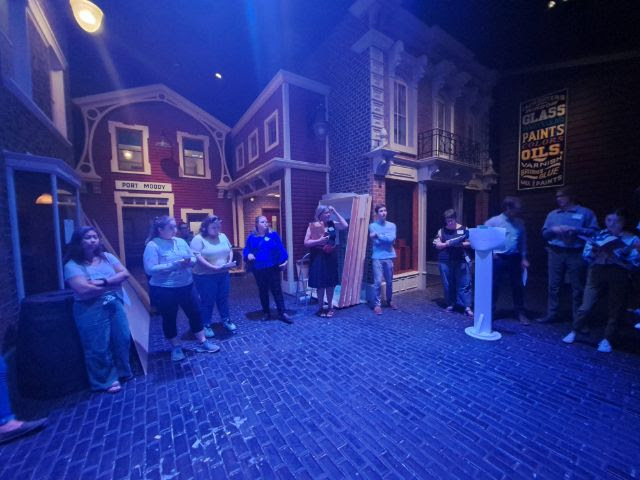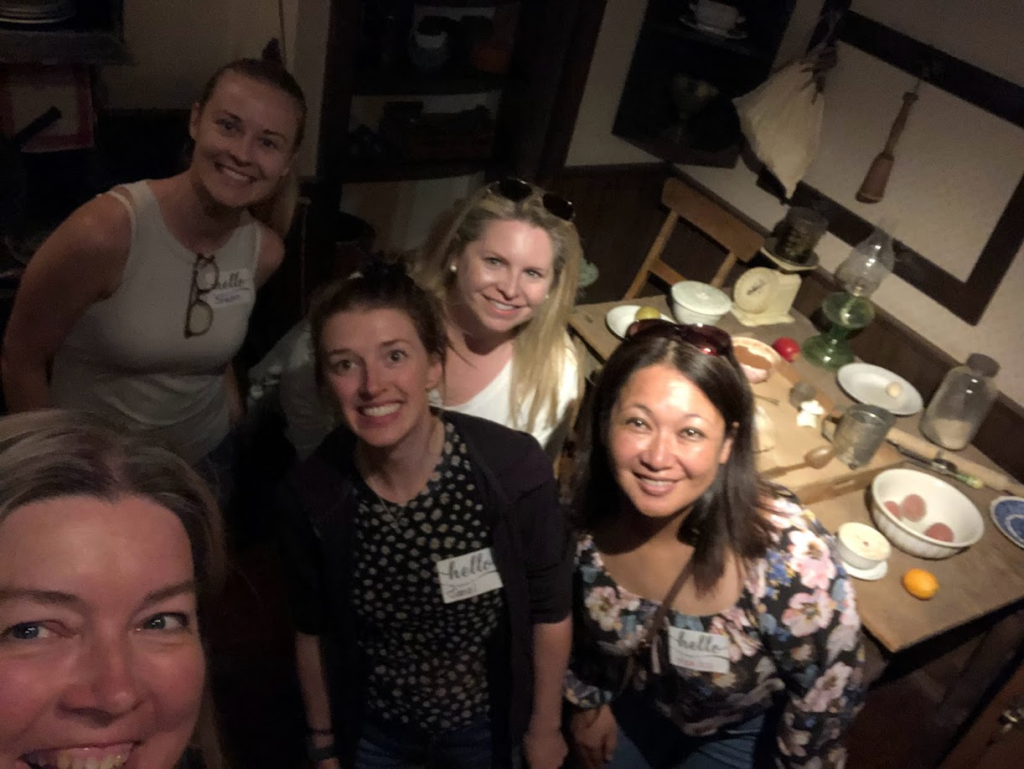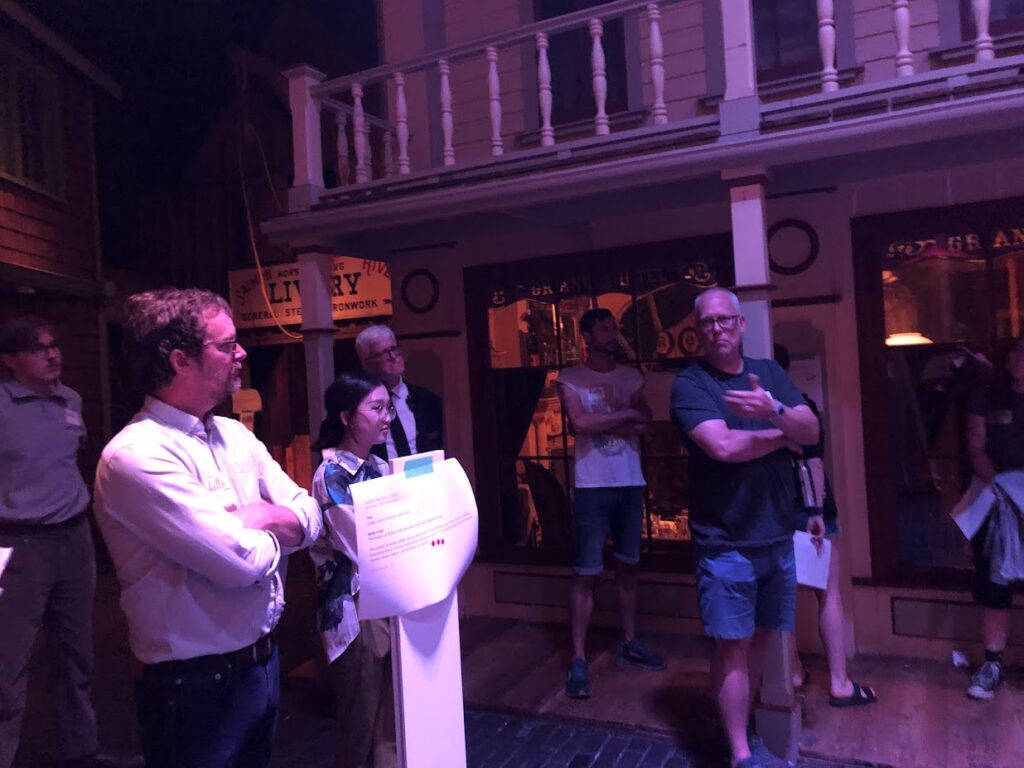
Last week the Royal BC Museum reopened their “Old Town” gallery, which had been closed since December 31, 2021. The First Peoples Gallery and Becoming BC stayed closed and will remain so until after a long process of consultation and major redesign. The excellent Our Living Languages exhibit was transformed into travelling exhibits, which are currently on display at the Agassiz Harrison and Fort Nelson Heritage museums.
I will not wade into the long series of events that led to the November 03, 2021, announcement of this closure, or the series of developments and decisions that led to the May 2023 announcement that just Old Town would re-open.
I will instead focus this blog on how the process underway at the RBCM became a cool professional learning opportunity for some teachers and education students, and how it can also be something to inspire more critical history teaching in museums in schools.
A brief interlude to situate myself in this story…
I spent a lot of time in Old Town as a kid. Every month or two when my Dad was alive (I lost him just before my 11th birthday), he and I hopped into the Buick Century station wagon to drive to Victoria from Nanaimo. We had lunch and Boston Cream Pie at Paul’s Restaurant then spent a couple of hours on the 3rd floor of the RBCM.

My favourite spots to linger were the silent film theatre, the train station, and outside the kitchen, smelling the apple pie. It was quiet and dark and immersive. Once my husband and kids and I returned to the island from Vancouver, the regular trips from Nanaimo to the museum began again, this time with a new tradition of ice-cream from Beacon Hill Drive-In. It felt like nothing had changed in Old Town from my childhood, apart from the 1992 addition of a Chinatown exhibit in Old Town that had been developed in co-operation with the Victoria Chinatown Lions Club, but has also been critiqued in its portrayal of that community.
As a history-teacher-mom, I did my best to top up the experiential with the analytical on these trips, but then I, too, would be lured in by that smell of cinnamon and the shadow of the passing train.
My family made a trip to the 3rd floor on its last day open.

I was now teaching Socials Methods to future teachers and one of my sons was studying history and political science at university, so we moved through the galleries with a more interpretive focus. We carefully read the panels in Becoming BC and wondered how long it had been since anyone considered rewriting them:

We discussed the stories that a visitor would take away from the exhibits and those that were missing. Where was the Japanese Internment? Nowhere. Would anyone learn about the Fraser Canyon War in the gold rush exhibit that had been introduced in 1992? No.

As we considered the layout of the entire 3rd floor, we also thought about what it might convey about the shared history on this land that the First Peoples Gallery was physically entirely separate from the settler one.
Were we also feeling nostalgic and that we would miss visiting? Yes – that too.
The photos I took that day, I would later share with my students to get them engaged in some thinking about museums from our classroom.
A Unique Opportunity for Professional Learning
When the RBCM embarked on their public consultation process about the future of the museum and announced that Old Town had not actually been dismantled, I contacted Chris O’Connor, the RBCM’s Director of Community Engagement and Regional Partnerships, and my UBC colleague Dr. Lindsay Gibson, so we could discuss getting teachers and education students connected to this process through a professional learning session. I was intrigued by the prospect of doing this work in the closed parts of the museum, and hoped that would draw participants to come out on a lovely spring Saturday afternoon.
As we began our planning, there was another important announcement. The government issued a press release announcing that Old Town would reopen to visitors on July 29, 2023. There was now a timely – urgent, even – process that museum staff would be following to get Old Town ready to reopen, with changes.
Our free (and fully subscribed) session “Thinking Critically About Museums” was held at the RBCM on May 27. 35 teachers and teacher candidates from up and down the island and from the lower mainland came together for the afternoon.


Lindsay started us well by discussing the high level of trust Canadians have in museums and some of the benefits and challenges of using museums to teach Social Studies.

Chris then shepherded us into the staff freight elevator to the closed 3rd floor. There was a sense of some giddiness as the elevator rose. The doors opened to the former 20th century exhibit, its display cases now gone and replaced with an empty flex space for future exhibits. We began our tour of the closed Becoming BC in the farm yard. While the horse and the Discovery ship at the other end were still in place, many other parts of this gallery were now disassembled.

We arrived in Old Town and found the gallery we remembered was largely the same, apart from an empty storefront and a room in the hotel. Pieces of paper with photos, notes, and sticky dots were placed around the gallery as part of the process that museum staff were using to decide what elements to keep and those to add to or redesign.
Old Town has always been an immersive gallery, but text panels were now to be added to give more context and share additional stories that have not been told there before. Some flex spaces would be introduced to allow a rotation of new stories and artifacts to be showcased in the space.
Activity 1: Deconstruct
Brent Geerts, a Belgian PhD student had joined our team. Brent was visiting BC for a month to examine how BC museums approach re-imagining our colonial legacy, an issue that resonates in Belgian and other European museums.
For our first activity, Brent offered participants a list of questions they could use to deconstruct objects and exhibits. The list was inspired by one he had located in a German museum. Some of the questions will seem familiar to anyone who was engaged students in interrogating artifacts, but others were newer to me. Brent had particularly highlighted the value of asking questions about the provenance of objects in the museum.
9. How did the exhibited object end up in the museum?
This is timely and important both for the RBCM and many of the other museums Brent studies. The full list of questions is available here.

At this moment I will take considerable responsibility for a short delay in beginning our analysis of the exhibits. Some of us were too busy posing for photos. My history student son Henry was back with me again, along with our friend, BC historian Dan Marshall. We captured Dan photo-bombing us.

Then… LOOK!! WE ARE ACTUALLY IN THE KITCHEN WITH THE PIE WE SMELLED FROM BEHIND A BARRIER FOR DECADES!



Luckily Brent’s questions were so interesting and important that we were back “on task” quickly. We came back to share what we were able to notice when we looked at the galleries and artifacts with a structured critical lens, and how we could do the same with students in this or any other museum.

Activity 2: Reconstruct
I led the group’s second task in Old Town. As we had spent time deconstructing the gallery, now it was time to put on our curator hats and think about how we might redesign a particular exhibit or even the entirety of the 3rd floor.

We captured and shared our ideas on a Padlet, then moved back downstairs to engage in a feedback session, led by Chris. Just as Chris and his colleague have been travelling around the province collecting feedback to inform the future of the museum, the teachers and future teachers at our session now offered their perspectives.
A summary of the results of the first phase of the museum’s consultation process and opportunities to participate in deeper discussions in the next phase are at this page. With Old Town now open, visitors to that gallery will also be invited to give feedback on what they experienced in the visit and what they would like to see for the future.

Authentic Learning
The tag-line for this blog and the focus of much of my interest in research and teaching is about the value of situating learning in real-world places, problems, and processes.
It was important to me that we have this session immersed in the gallery we were considering, even though we would have been able to accommodate including many more educators from around the province if we had done the session online. I wanted to get across the power of using our senses to experience a place while engaged in this hard thinking about it.
This is certainly also an authentic problem and process. That people across the province have been expressing passionate opinions about the future of the RBCM and how it tells the multitude of stories of human history in BC makes for a uniquely authentic opportunity for teachers to directly engage their students in this conversation. This is a process not just for high school students, but younger kids too. My 11-year-old daughter Jane tagged along with me to a public consultation meeting in Nanaimo in February, and decided to stand up and offer her suggestion to have more interactive features in the galleries, like the ones she had used at MONOVA and the Museum of Vancouver.

Authentic participation by students in the work of the museum is not anything new for the RBCM, as prior to the pandemic, they worked with schools in Greater Victoria in a Partner School Project. One of our teacher-participants had partnered with the museum to bring his students into the museum several times, and his students’ research and exhibits had been shared with the public in a temporary display. Imagine what kind of learning that must have been for those students!
The work that we did in our May 27 session was also meant to be transferable to visits to and collaborations with community museums across the province.
Have you used museums in a way you’d like to share? I would love to hear your ideas and questions in a comment.

Here are the ways I have used our museum with my classes.
Research in the archives about a question the class chose via a consensus process . Led by archivist
Visit the bunker under our museum. Questions for students to consider like who would be there, the supplies, the operations, etc.
Visit the permanent display and count who was recognized—men women white indigenous racialized
Visit rotating displays. Have students select a piece of art, do a sketch, how it impacted them and why they chose it.